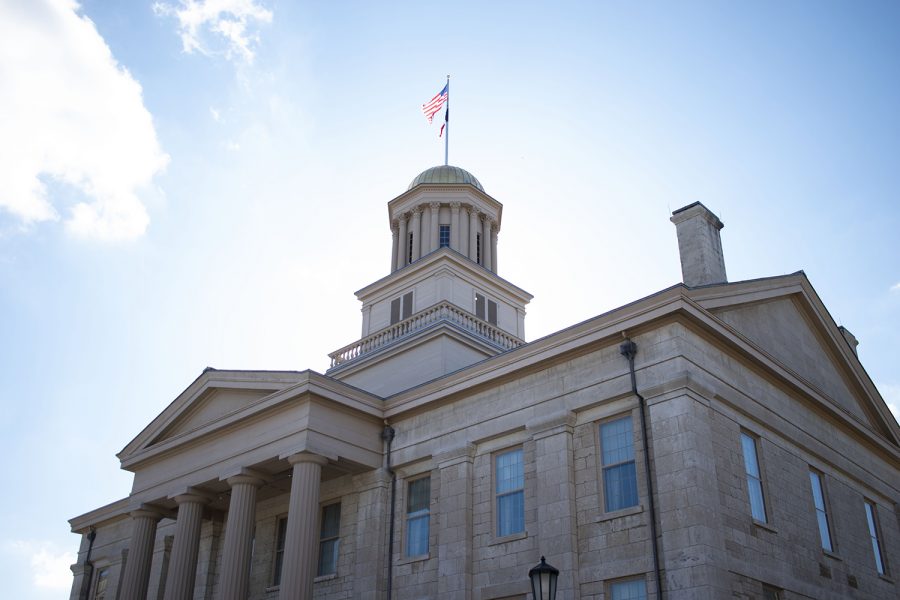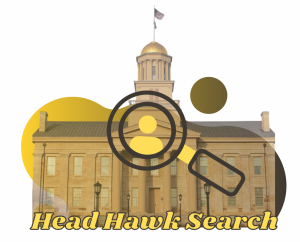Fact Check | The facts behind funding Iowa’s public universities
The Iowa Legislature is proposing a small increase or freeze in appropriations this year, citing federal aid and lower costs as reasonings.
The Old Capitol Building is seen on Monday, March 1, 2021.
April 25, 2021
PolitiFact Iowa is a project of The Daily Iowan’s Ethics & Politics Initiative and PolitiFact to help you find the truth in politics.
Edited by Lyle Muller and Sarah Watson
If your time is short
- Three different budget proposals for funding Iowa’s public universities from the state government exist in the Iowa Legislature. Gov. Kim Reynolds proposed a $15 million increase for state universities, the state Senate proposed an increase of $8.2 million, and a House bill proposed no increase.
- House Republicans used the state Board of Regent universities’ COVID-19 relief allocations to justify no budget increase, but the universities are limited in how they can use those funds.
- Before the pandemic, the regents were already experiencing a reduction in funding for higher education.
Iowa’s state Board of Regents has requested an $18 million state appropriations increase for the University of Iowa, Iowa State University, and University of Northern Iowa in fiscal 2022, which starts July 1, and the restoration of an $8 million cut the state made to the budget last year.
While Iowa Gov. Kim Reynolds’ budget proposal recommended a $15 million increase for the state universities and the state Senate has proposed an $8.2 million increase to replenish last year’s cuts, the state House passed a bill, House File 868, out of its Appropriations Committee on April 12 that would provide no increase to the regents and freeze tuition in the state’s public universities.
The chambers must come to an agreement to set the state’s fiscal 2022 budget. As they do, they will have to consider the following:
Funding from COVID-19 relief
Republican legislators in the House have argued that money the regents have or will receive from federal COVID-19 relief bills, as well as declining enrollment, can make up for a funding increase the regents seek for Iowa’s three public universities.
Democrats have criticized this line of thinking, saying other educational organizations receiving a state funding increase also had received COVID-19 relief, and that the federal relief packages limited how the funds can be spent.
Josh Lehman, the regents’ senior communications director, wrote in an email to The Daily Iowan that the regents received roughly $115 million in the first two rounds of COVID-19 aid. Allocations for the third package, the American Rescue Plan, had not yet been awarded as of April 23.
Lehman said about $45 million from the first two bills went to student aid. The remaining funds are to assist universities with the negative financial impacts they experienced as a result of the pandemic. None of the relief money can be used for general operating expenses, he said.
Lehman said the first relief bill required half of the funding received by the regents to be awarded to students as aid, and that the second one required the same amount awarded in the first bill to be given out as aid.
At least half of the funds from the third bill must go to students as aid, but guidelines for permitted uses for the remainder of the allocation hadn’t been released, Lehman said.
“The institutional funds received are restricted to defray expenses and lost revenue related to the pandemic, including costs associated with the changes to the delivery of instruction and refunds previously made to students for room and board costs and other fees,” Lehman wrote in an email to the DI.
Democrats used this point in a House Appropriations Committee meeting on April 12 to counter a Republican proposal to give no additional state funding to the regents in fiscal 2022, which begins July 1.
RELATED: Bill to freeze funding for regents universities passed through state House Appropriations Committee
Reduced enrollment
From fall 2019 to fall 2020, enrollment at all three regents’ universities decreased 4.4 percent, with the UI decreasing 2.5 percent, ISU decreasing 4.7 percent, and UNI decreasing 9.3 percent. Fall 2020 enrollment numbers were similar to fall 2010 enrollment.
In recent years, enrollment peaked in fall 2016. Fall enrollment at the universities decreased in 2018 and 2019, pre-pandemic.
Other public educational institutions in the state, however, also had enrollment decreases this year. Community college enrollment in Iowa decreased 1.3 percent for credit enrollment and 23.2 percent for noncredit enrollment. Enrollment in the community college Adult Education and Literacy program decreased 16.4 percent.
Reduced enrollment also means fewer students pay tuition for the universities. As Iowa becomes more reliant on tuition dollars than state appropriations, fewer students mean less money for the universities.
State spending cuts
In their state appropriations request for fiscal 2022, the regents noted that appropriations for higher education in 2021 were $63 million less than the appropriation in 2001.
“Funding challenges are common across the United States and are not unique to the state of Iowa,” Lehman wrote. “The Board has done extensive research and had numerous public meetings over the past several years in coming up with the best way to manage our resources. The Board has had a positive partnership with the state of Iowa for more than 100 years, and we will continue to work with the governor’s office and legislature to advocate for the level of funding necessary to provide high quality education for our students.”
According to a Pew Charitable Trusts study, funding for higher education has increasingly come from the federal government rather than the state government across the country since 1990. The study found that state funding, per student, in 1990 was almost 140 percent more than that of the federal government nationally. By 2015, state funding per student was only 12 percent more than federal levels.
Data provided to the DI by Jeneane Beck, a spokesperson for the UI, showed that the Iowa state budget was $4.36 billion in fiscal 1998, with the UI receiving an appropriation of $223.6 million. In fiscal 2021, the state budget was $7.78 billion and the UI appropriation for general operating was $215.6 million, $8 million less than what the university received in 1998, despite an enrollment increase of 3,859 and a state budget increase of $3.42 billion. The UI also received state appropriations for its Oakdale Campus, Hygienic Lab, and some health services, bringing the total appropriation to $230,824,527.
“From 1970 to the year 2000, state appropriations made up more than 60% of the university’s General Education Fund while tuition covered less than 30%,” Beck wrote. “Over time those numbers reversed – placing more of the burden on students.”
The UI’s general fund appropriation was $248,277,649 in fiscal 2000, a year in which the original appropriation was cut. ISU received a $262,026,484 revised appropriation, and the UNI received $88,497,226 that year, regents’ documents show.
ISU’s fiscal 2021 general education appropriation was $172,144,766, although appropriations for agriculture extension services brought the total appropriation to $227,360,173. UNI received $98,296,620, plus additional special purpose money for a total of $106,408,499, regents’ documents show.
According to the data from Beck, the UI would receive $100 million more annually from the state had funding kept pace with inflation, using the Consumer Price Index.
Editor’s note: This article has been updated to reflect that the Pew research on higher education funding was from the Pew Charitable Trusts, not Pew Research Center.
Sources
Board of Regents, “FY 2022 AND OTHER APPROPRIATIONS REQUESTS,” September 23, 2020
Iowa Department of Management, “Condition of the State: State Budget,” January 12, 2021.
Iowa Capital Dispatch, “Senate proposes $8.2 million increase for public universities,” April 13, 2021
Iowa Legislature, “House File 868,” April 12, 2021
Josh Lehman, April 23, 2021
Congress, “H.R.1319 – American Rescue Plan Act of 2021 SEC. 2003. HIGHER EDUCATION EMERGENCY RELIEF FUND,” March 11, 2021
Board of Regents, “Fall 2020 Enrollment Report,” November 18, 2020
Board of Regents, “Fall 2019 Enrollment Report,” November 14, 2020
Board of Regents memorandum, “Approval of Detailed Budgets — University of Iowa, July 7, 2000
Board of Regents memorandum, “Approval of Detailed Budgets — Iowa State University, July 7, 2000.
Board of Regents memorandum, “Approval of Detailed Budgets — University of Northern Iowa, July 7, 2000.
Iowa Department of Education, “Annual Condition of Iowa’s Community Colleges Report, Academic Year 2020,” January 28, 2021
Jeneane Beck email, March 30, 2021
Pew, “Two Decades of Change in Federal and State Higher Education Funding,” October. 15, 2019.






